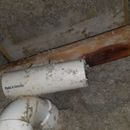Lead pipe boot leaking at radon pipe – Leak in attic
The weather has been pretty brutal here in Chicago for the last couple of weeks, with record snowfall and record cold temperatures.
I thought I had an issue with my main plumbing waste vent (a question for another day), but when I went into the attic today, it turned out there was a leak around the penetration in the OSB roof sheathing for the radon pipe. The OSB is pretty soaked, about 6-8″ away from the penetration, following the pitch of the roof.
About a foot of snow has been sitting on the roof for the last 3 weeks, but once temperatures rose into the 40’s yesterday and today, it’s all since melted.
I’m assuming I just have the roofing company come back, hopefully tomorrow, and replace the lead boot?
I removed all the wet cellulose in the area (one black garbage bag), and I’ve left the area open to dry down to the wet 2×4 (in the picture) and the Intello directly below that (our ceiling air barrier). I’m assuming this is ok to do since temperatures will remain in the 40’s until tomorrow night.
But I’m also assuming I need to get new cellulose put back before the temperatures fall again. Is this ok to do even though I’m sure that 2×4 will still be partially wet tomorrow?
I checked the trusses in the area under the cellulose, and they’re all dry, so it looks like the leak is pretty recent and contained. Maybe the combination of snow on the roof with record low temperatures was enough to allow water, once the snow started to melt, to find a path around the lead boot and into the attic?
Once the lead boot is replaced, does it make sense to apply a product like Prosoco’s Joint and Seam (vapor open) around the penetration in the OSB and the radon pipe from the attic side?
My thought was, if water finds its way to this area again it would have to migrate through the OSB where it could dry to the attic side of the roof — we have a ventilated roof so a lot of air is running up the roof sheathing to the ridge vent. Bad idea? I thought this might be better than my current situation where water was falling directly onto the cellulose.
GBA Detail Library
A collection of one thousand construction details organized by climate and house part










Replies
Sorry, photo I posted is upside down.
If it’s just leaking around the pipe and not through the flashing part of the boot, there is a slide-on cap you can use to shed water away from the boot-to-pipe seal. A lot of people use these as an extra layer of protection but they are also handing to band-aid simple leaks before a real repair can be made. Just a thought.
Bill
I'm afraid I don't have useful advice to offer in solving the problem, but I do want to offer the perspective that I think we should be getting away from using lead flashing. If we wanted to use it responsibly, there's be a lot of care needing in handling it, and there's still some amount of lead that runs down the roof as the lead very slowly corrodes. And how can we ensure that 50 years hence when it's replaced the scrap will be recycled or properly treated as toxic waste?
I thought lead pipe boots were only used for copper vent pipes. I've never heard of lead pipe boots being used for a PVC vent pipe.
Thanks for the responses!
If anyone else has ideas or suggestions, please let me know.
Martin, around us lead boots over pvc is the norm.
Any reason not to do it? Roofers seem to agree it's the best long-term solution.
Thanks again!
Lead isn’t a particularly safe material from a health perspective. Many products have been moving away from lead (an example is the push for removing lead from all aspects of plumbing). Admittedly using lead flashing is probably not much of an issue from a practical standpoint, but there are other materials available that don’t have the hazards of lead.
I haven’t seen lead pipe boots in a looong time. Everyone uses either the rubber gasket kind with built-in flashing (usually for residential projects), or the stepped rubber boots that you cut for your particular pipe size and then attach to a seperate flashing piece.
Your roofers are probably used to lead since it’s been around forever. There have been newer options available for a long time, and the rubber boots should last for decades.
Bill
Eric,
Do you have a 2 piece zinc plated roof jack with the lead top? There is typically a tightening band that goes around the lead top and this fastens to the PVC pipe. The idea is the top portion of the roof jack will float with the movement of the PVC yet remain waterproof. The lead top can get thin and show holes and at this point should be replaced.
Just purchase one of those metal roof collars with the rubber boot. Remove the rubber boot, or cut a square portion around the boot, and slide it down the pipe and cover the lead. The rubber may cover well enough to work alone or it can be caulked along the bottom onto the existing collar. If you left a little metal around the boot, it can be caulked and nailed down. But at least it will be tight around the plastic pipe since the lead is probably floating.